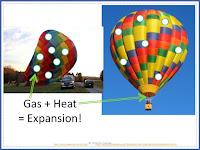Make a diagram in your notebook:





When we add thermal energy to a subtance, the state of the substance changes or the volumne of the substance increases.





When we add thermal energy to a subtance, the state of the substance changes or the volumne of the substance increases.
MELTING
The thermal energy in a solid increases, and it becomes a liquid.
Examples: ice cream / butter / the wax of a candle / an ice cube
EVAPORATION
The thermal energy in a liquid increases, and it becomes a gas.
Example: boiling water
EXPANSION
The thermal energy of a substance increases, and its volume increases too.
Substances occupy more space when they are heated up.
Example: a hot air balloon / mercury in a thermometer








No hay comentarios:
Publicar un comentario